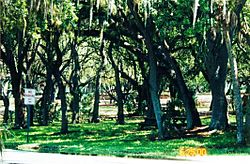Philippe Park facts for kids
Quick facts for kids Philippe Park |
|
|---|---|
 |
|
| Location | Safety Harbor, Florida |
| Area | 122 acres (49 ha) |
| Created | 1948 |
| Operated by | Pinellas County Parks & Recreation |
Philippe Park is a beautiful park located in Safety Harbor, Florida, within Pinellas County. It's a great place to explore history and nature. The park is named after Odet Philippe, an important early settler in Florida. He is famous for bringing grapefruit to the area!
The park covers about 122 acres. This land was once part of Odet Philippe's own plantation. He was the first non-native person to settle in Pinellas County, arriving way back in 1842. Odet Philippe is buried somewhere in the park, but his exact burial spot is not known.
One of the most special parts of Philippe Park is an ancient Tocobaga Indian mound. This mound is so important that it's recognized as a National Historic Landmark and is known as the Safety Harbor Site.
Contents
Exploring Philippe Park
Philippe Park is a large and interesting park in Safety Harbor, Florida. It's a popular spot for families and anyone who loves the outdoors. The park offers many activities and a chance to learn about Florida's past.
The park was created in 1948. It's managed by Pinellas County Parks & Recreation. You can enjoy picnics, playgrounds, and beautiful views of the water here.
The Story of Odet Philippe
The park is named after Odet Philippe, a fascinating person from Florida's history. He is known for introducing grapefruit to the state. This fruit is now a big part of Florida's agriculture.
Odet Philippe was the first non-native settler in Pinellas County. He arrived in 1842, long before many others. His plantation was located right where the park is today.
The Ancient Tocobaga Mound
Inside Philippe Park, you'll find a very old Indian mound. This mound was built by the Tocobaga people. They were a Native American group who lived in this area a long time ago.
This large mound is one of the last remaining signs of the Tocobaga people on the Pinellas Peninsula. It's a significant historical site. It helps us understand the ancient cultures that lived here.
A Glimpse into History: Spanish Encounters
Historical records tell us more about the Tocobaga mound. In 1566, a famous Spanish explorer named Pedro Menéndez de Avilés visited the site. He was the founder of St. Augustine, Florida.
Pedro Menéndez came to try and make peace between the Tocobaga and another group, the Calusa. The Calusa lived to the south. During his visit, Menéndez also set up a small Spanish outpost nearby.
However, the outpost didn't last long. By 1567, reports said the Tocobaga had destroyed it. Eventually, the temple mound was left empty. The Tocobaga people faced many challenges. They suffered from European diseases. Some were also forced into slavery in the Caribbean.
Gallery













